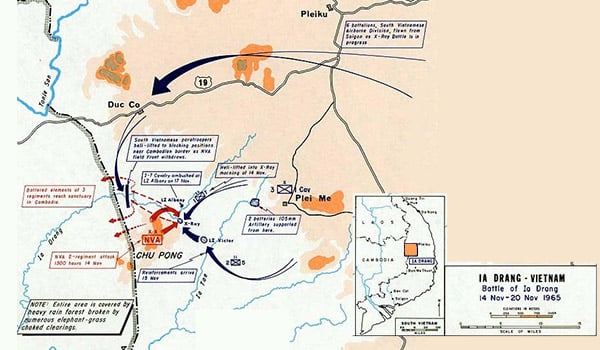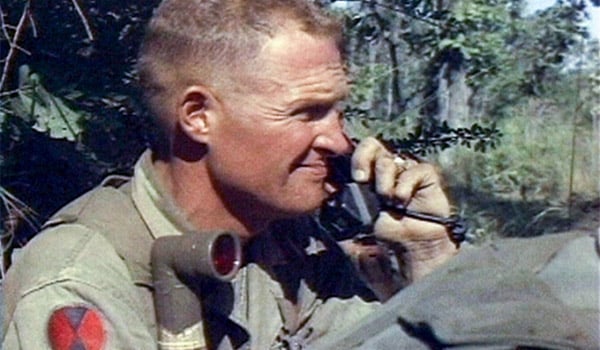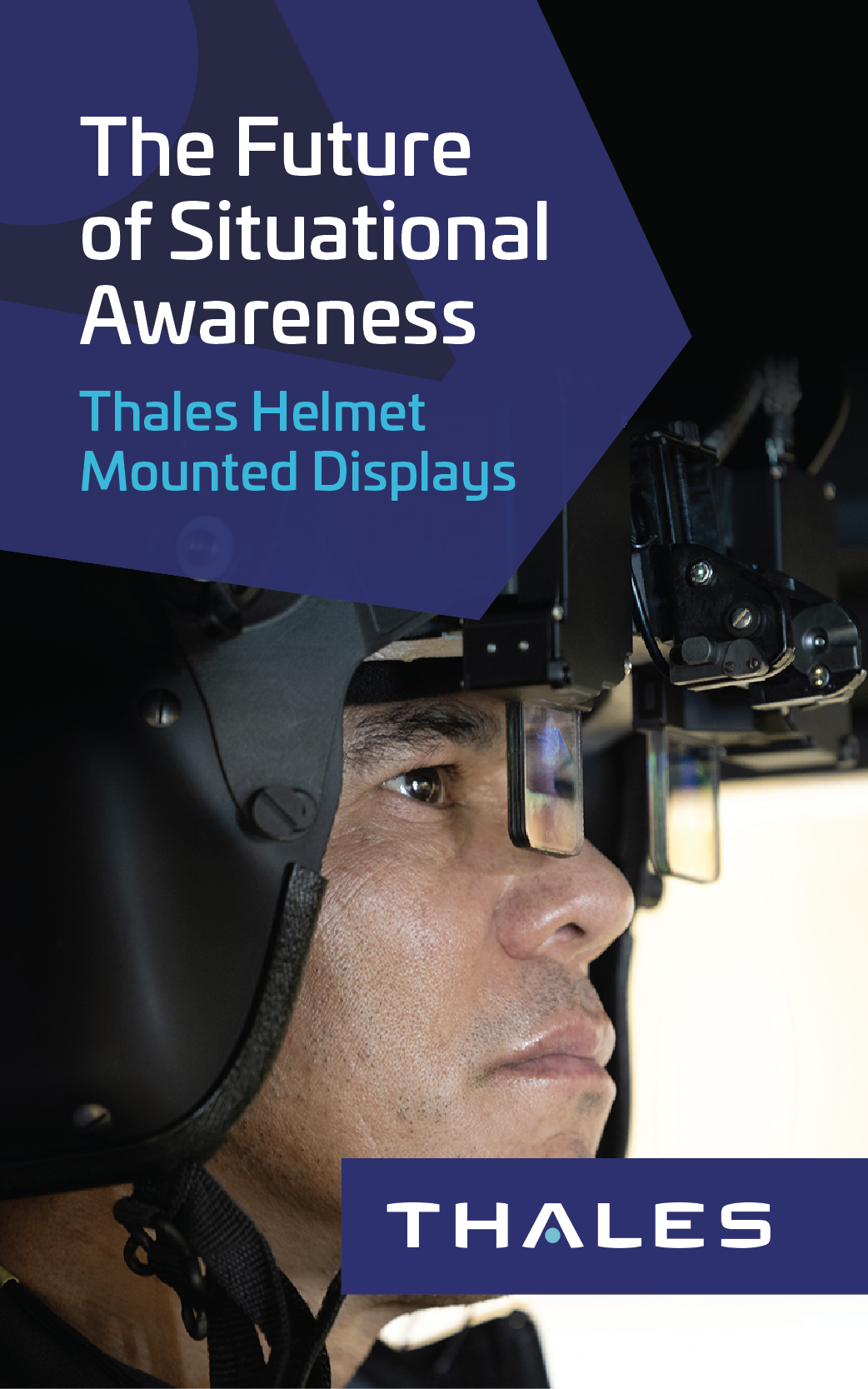
Historical Perspective / By Mark Albertson: Editor’s Note: This is the first of two articles commemorating the 55th Anniversary of the Battle of Ia Drang, Vietnam

Helicopter of MAJ Bruce Crandall, commander of the 229th Assault Helicopter Battalion, low over LZ X-Ray.
Fifty-five years ago, 1st Cavalry Division (Airmobile) went on the attack. Division commander, MG Harry W.O. Kinnard, ordered COL Thomas W. Brown, commander, 3rd Brigade, 1st Cavalry Division, to send units south of the Ia Drang River, within the shadow of the Chu Pong mountain range. Brown’s units were the 1st and 2nd Battalions, 7th Cavalry Regiment and 2nd Battalion, 5th Cavalry Regiment. To the east, some six or seven miles at LZ Falcon, two batteries of 105 mm howitzers would be set up for fire support. 1st Battalion, 7th Cavalry, commanded by LTC Harold G. Moore, was to be inserted by helicopter into LZ X-Ray, 1030 hours, November 14. Objective: Engage in search and destroy operations in the Ia Drang Valley.
The Initial Assault
1017 hours, artillery loudly opened the debate, bombarding Landing Zones X-Ray and Tango for eight minutes; followed by a twenty minute shelling of the former. Once lifted, UH-1B helicopters from the Aerial Rocket Artillery battalion continued the softening up process. The above remained on standby for continued support. Helicopter gunships escorted troop-carrying Hueys. The gunships lent suppressive fire with machine guns and rockets. Incoming lift copters saw their door gunners add to the suppressive fire as they landed Moore’s cavalrymen, with Company B making the initial assault.1

The battle of the Ia Drang, 14-20 November 1965; LZ-X-Ray in the center of the map./ U.S. ARMY GRAPHIC, WIKIPEDIA COMMONS
Sixteen helicopters inserted Bravo Company onto X-Ray. The clearing was expansive enough for 8 to 10 helicopters at a time. Turn-around time for helicopters to bring in A, C and D Companies had been planned for no more than thirty minutes.
“Once on the ground, Alpha and Bravo Companies were to assemble in attack formation just off the north and northeastern sectors of the landing zone, prepared to search east and northeast on order, with Alpha Company on the right. Designated first as a reserve force, Charlie Company would assume the security mission from Bravo Company on order, with a prepared task to move west and northwest, searching the lower portion of the Chu Pong, located just west of the landing zone. Bravo Company had priority of fire at the start, but once the westward push from the landing zone began, priority would shift to Alpha Company.”2
The Battle Develops
During the course of the battle, November 14 and 15, the UH-1 Huey helicopter proved invaluable. MAJ Crandell commanding the 229th Assault Helicopter Battalion lifted Moore’s cavalrymen into action. During the fourth round of landings, the NVA took X-Ray under fire, increasing the intensity as the Communists awoke to the danger. General Chu Huy Man attacked the cavalrymen from all sides, while raining 60 mm and 81 mm mortar rounds onto X-Ray. By 1330, Bravo Company was being heavily attacked by two NVA companies, supported by rocket and mortar fire; and its right platoon was in danger of being cut off.3

LTC Harold G. Moore, on his phone, during the battle of LZ X-Ray, November 14-15, 1965./ WIKIPEDIA COMMONS PHOTO
Alpha Company was ordered to protect the left flank of the heavily engaged Bravo Company; in addition to assisting Bravo to come to the relief of the beleaguered right platoon threatened with encirclement.4 Tube artillery and ARA began a pummeling of the Chu Pong foothills and enemy infiltration routes.5
Meanwhile, as Bravo Company was in a thick of a fight, Charlie Company was making its entry into a hot landing zone. “In fact, as the last elements of C Company landed, lead elements of D Company landed. “As they landed, the helicopters took numerous hits, but none were shot down.”6 However, “one radio operator was killed before he could dismount from a helicopter and the door gunner and pilot were wounded. “Colonel Moore stopped the other eight UH-1-Ds from landing. “Those who landed from D Company immediately became engaged in a fire fight near A Company. “The fighting became more intense. “Colonel Moore decided to pull back A and B Companies under cover of heavy supporting fire and smoke to the fringe of the landing zone and set up a tight defensive perimeter for the night.”7
Sustaining the Fight
MAJ Crandall asked for volunteers to fly in needed supplies, evacuate wounded and bring in reinforcements. “Tactical air flew missions throughout the night and the Air Force flare ship maintained constant illumination of the battle area. “Pilots of lift ships braved the dangers of the fire-swept L-Z to bring in reinforcements and re-supply and carry out wounded and dead.”8
As night fell, attempts to break through to the “lost platoon” had come up short, though communication was maintained. The NVA conducted probing attacks against Moore’s perimeter. Attacks against the isolated platoon, as well as X-Ray, were repulsed. Defense was bolstered by gun batteries at Falcon. More than 4,000 rounds of ordnance had been expended in close support.
To be continued.
ENDNOTES:
- See page 78, Chapter IV, “The First Airmobile Division and the Buildup, 1965: The Ia Drang,” Vietnam Studies: Air Mobility, 1961-1971, Lieutenant General John J. Tolson.
- See pages 7 and 8, “Ia Drang Valley Campaign Oct.-Nov.1965,” by MSG Erik Wilson, MSG Jeff Noe, MSG June Pugh, MSG James Wells and MSG Shannon Boyer.
- See page 26, “Battle of LZ X-Ray,” by Captain Robert H. Edwards.
- See page 5, “After Action Report, Ia Drang Valley Operation, 1st Battalion, 7th Cavalry, 14-15 November 1965,” Commanding Officer, 3rd Brigade, 1st Cavalry Division (Airmobile).
- ibid page 6
- ibid page 7
- See page 78, Tolson.
- See page 141, “14 November, 1. Operations Summary, Operations Report, Lessons Learned, Report 3-66, The Pleiku Campaign.” The reference to MAJ Bruce Crandall asking for volunteers to maintain that lifeline of supply and reinforcements was in response to LTC Moore closing down the landing zone so as to prevent Army Aviators from incurring heavy losses which would threaten the continuing operation of the lifeline. This can be found on page 128, “Landing Zone (LZ) X-Ray –desperate times, conspicuous heroism,” A History of Army Aviation, by Dr. James W. Williams.
For greater detail on MAJ Crandall asking for volunteers to continue flying into LZ X-Ray, go to page 117, Chapter 9, “Brave Aviators,” We Were Soldiers Once . . . And Young, by LTG Harold G. Moore (Ret.) and Joseph L. Galloway. In addition, refer to pages 114 and 115, explaining how “slick crews,” those trained to fly in troops and supplies were also ferrying wounded. Transportation of wounded was the province of MEDEVAC; but, at this stage of the war, MEDEVAC commanders were denying their aviators and helicopters from landing in hot zones. Again, refer to Williams, page 128, as well with regards to commitment of MEDEVAC: “Casualties mounted quickly. The need for MEDEVAC was urgent, but the recent experience of losing these helicopters came into play. The unit called for MEDEVAC, but the new division policy for MEDEVAC required a cold LZ for five minutes. That was impossible. This left the lift unit to carry out wounded.”
Finally, we see Moore faced the prospect that without preserving Landing Zone X-Ray, he faced defeat.
Mark Albertson is the award-winning Army Aviation Publications Historian and a contributing editor to ARMY AVIATION magazine.
























